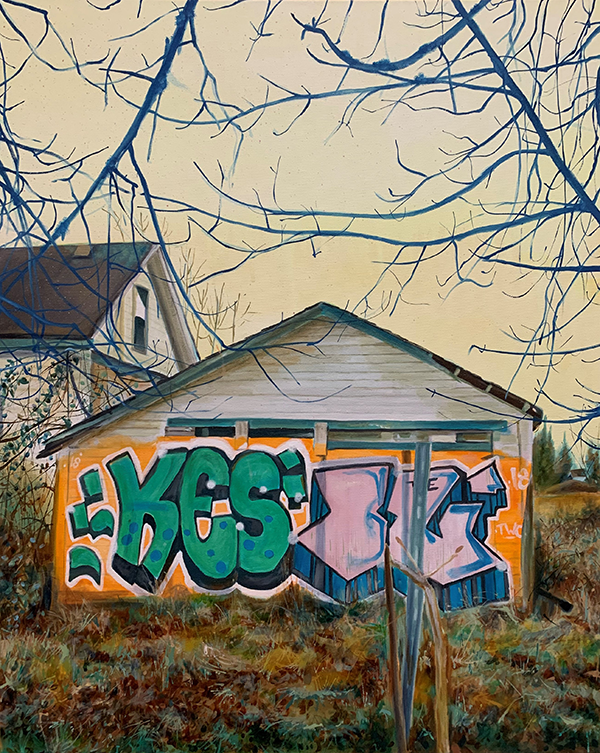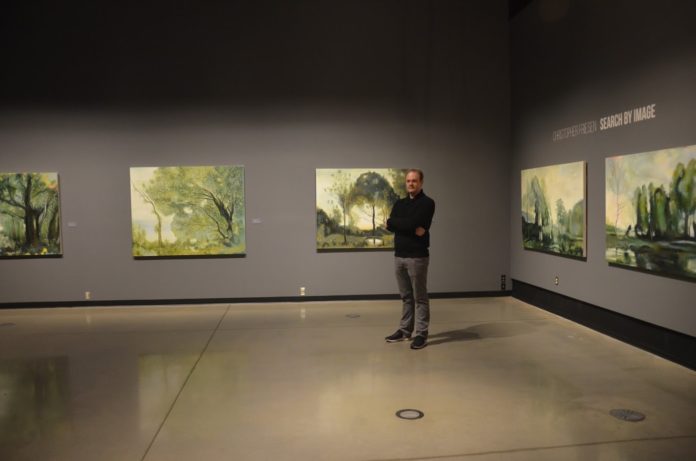Chris Friesen received his diploma in Fine Arts in 1997 from the University College of the Fraser Valley, his BFA degree in 1999 from the University of Lethbridge, and his MFA degree in 2002 for painting from the University of Regina. Chris has always had a passion for art, and when he was in university he decided he also wanted to teach it. Chris teaches visual art classes and is one of UFV’s primary painting teachers.
Have you always known you wanted to teach art? Or teach in general?
I always knew I wanted to be an artist. My daughter is eight years old right now and I can see her getting into drawing, and I remember when I was that age. That is just what was important to me. I hung out with people that did art, and I loved comic books. That’s really how I got my start, through comics and loving animation; I always loved Saturday morning cartoons. That’s really what I wanted to do — I wanted to be an animator.
I had a circumstance in my life where my dad was diagnosed with cancer, so I had a very kind of emotionally vulnerable time in my teens. It gave me an outlook on life where everything seemed bleak. But at that early age I thought, “Art is where it’s at for me. I’m just gonna make that my purpose and dedicate my time and energy to that.” In high school I did well, but art was my passion. I sort of motivated myself through high school. I really only went into art because of my love for it. When I was going to the University of Lethbridge I had this sort of click when someone asked if I was just going to be a starving artist, and then I just motivated myself to the more logical path of teaching art.

Are you looking forward to converting back to more in-person classes or did you prefer online?
I enjoyed it. Again, it was a challenge being a studio-based program. That is where we lived; we lived in the studio in a moment of production. I could look over my shoulder and immediately give feedback, whereas online it doesn’t allow for that. It’s a far more cumbersome way to communicate.
For instance, some upper-level students — I had two meetings with each individual group, and it took me three days to talk to a group of 20 people. If I had that group in front of me, I could’ve had that conversation over the span of one four hour class.
How was your transition from in-person teaching to online? Was it maybe a bit harder for you since you teach art?
Yeah, art was something I was a bit more skeptical about doing [online]. However, I do realize it’s a visual art form, and this is a visual communication platform so I adapted fairly quickly.
I think I needed to learn a lot more technology like recording and uploading. It takes a long time to plan what you want to do. I tried to only do one take to almost make the experience a bit more real for the students. But the technological side of it, in terms of trying to get a sense of what a painting is, is problematic because a painting is something physical in the world, and trying to get a picture or video representation of it just doesn’t do it. So, I think there’s a lot of students that didn’t really get that whole experience because they couldn’t physically see the thing.
When you’re looking at an image only with beautiful light behind it, it becomes more mysterious. When you look at it in real life, it’s all there. That’s the whole point of painting: everything is meant to be seen all at once, and how it’s produced. We just don’t have that on video.
Was there anything that really stuck out when teaching online classes that made it more difficult than in-person?
I think just part of what makes art work is trust, and getting to know students so they can be comfortable with you. So, communicating online is very difficult because it’s a mediated experience. I’m not talking to you, I’m talking to a phone that is connected to your phone and so on. So there’s mediation, whereas in-person there’s other conversations that take place. And again, I find that Zoom — when you have a Zoom call with eight people, there’s a lot that doesn’t get said. The thing with online teaching too is you’ll put out a response, and it’ll take a little bit to get a response.
Have you had any sort of leniency with your assignments while you taught online classes?
Yeah, if we went online, which we did, I would opt for asynchronous because people are functional at different times of the day. So, if I’m doing a synchronous Zoom session, I think it’s a waste of time because it becomes so passive. It’s supposed to be interactive, but it’s just not in the way that we need it to be for art.
Yes, we can have discussions like a lecture, but that’s not helping anyone. So, I love the asynchronous idea of allowing students to tune in when they want to or can tune in. And yes, was I lenient? 100 per cent. I think the fact that we are in a pandemic, there was a lot more consideration in terms of my expectations around assignments and due dates and just learning outcomes. I wanted to keep it as pure as I could to the studio experience, but obviously it just couldn’t be there. So, I think that just this past year and change, I’m far more empathetic to a student situation because I’m not the only class they’re taking.
Photo: Sharon Huget


